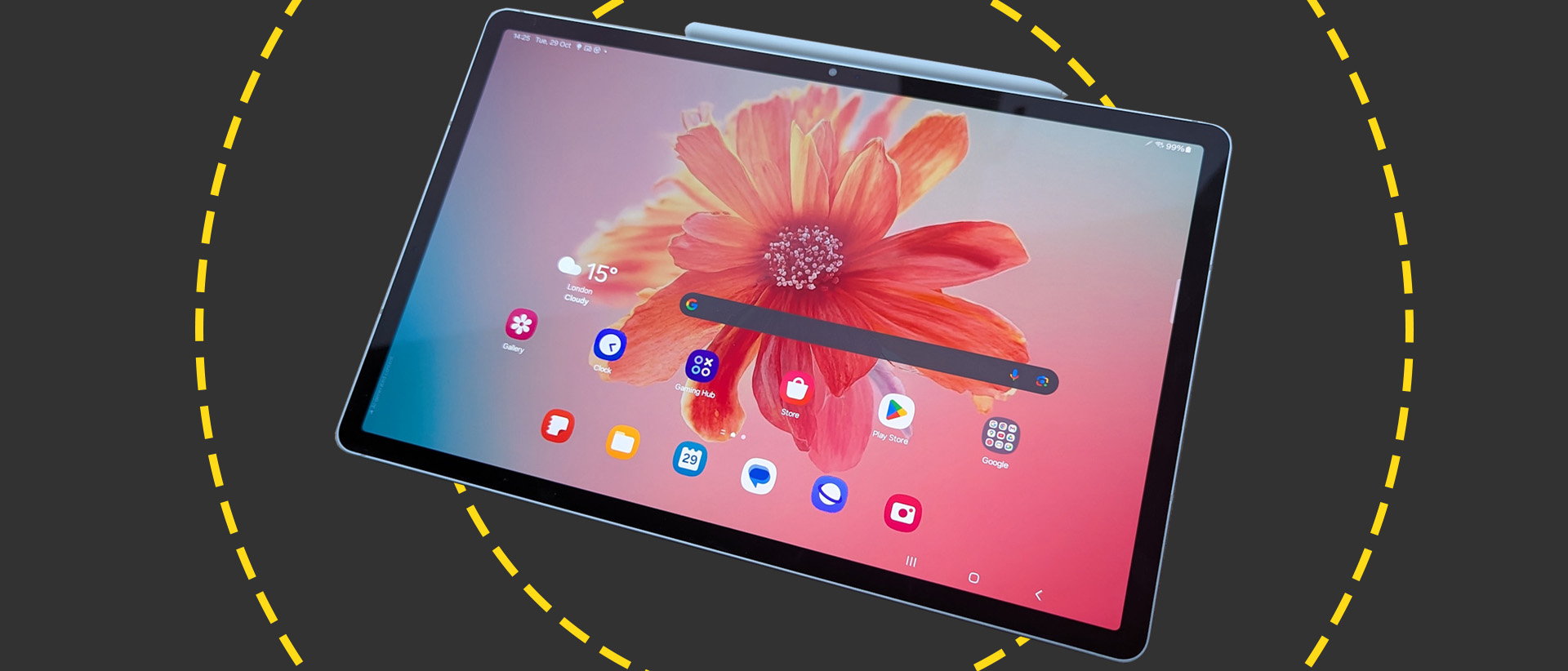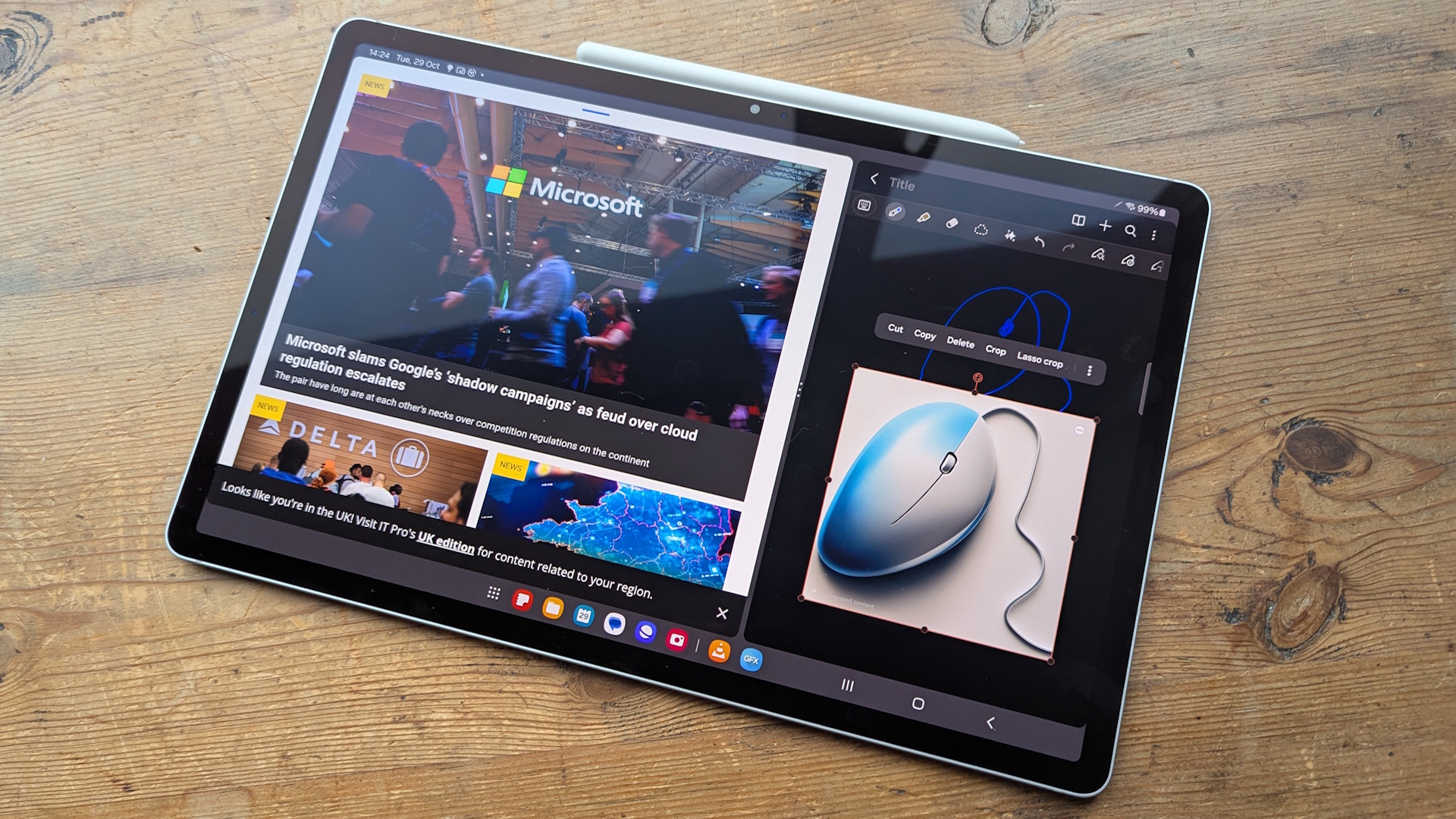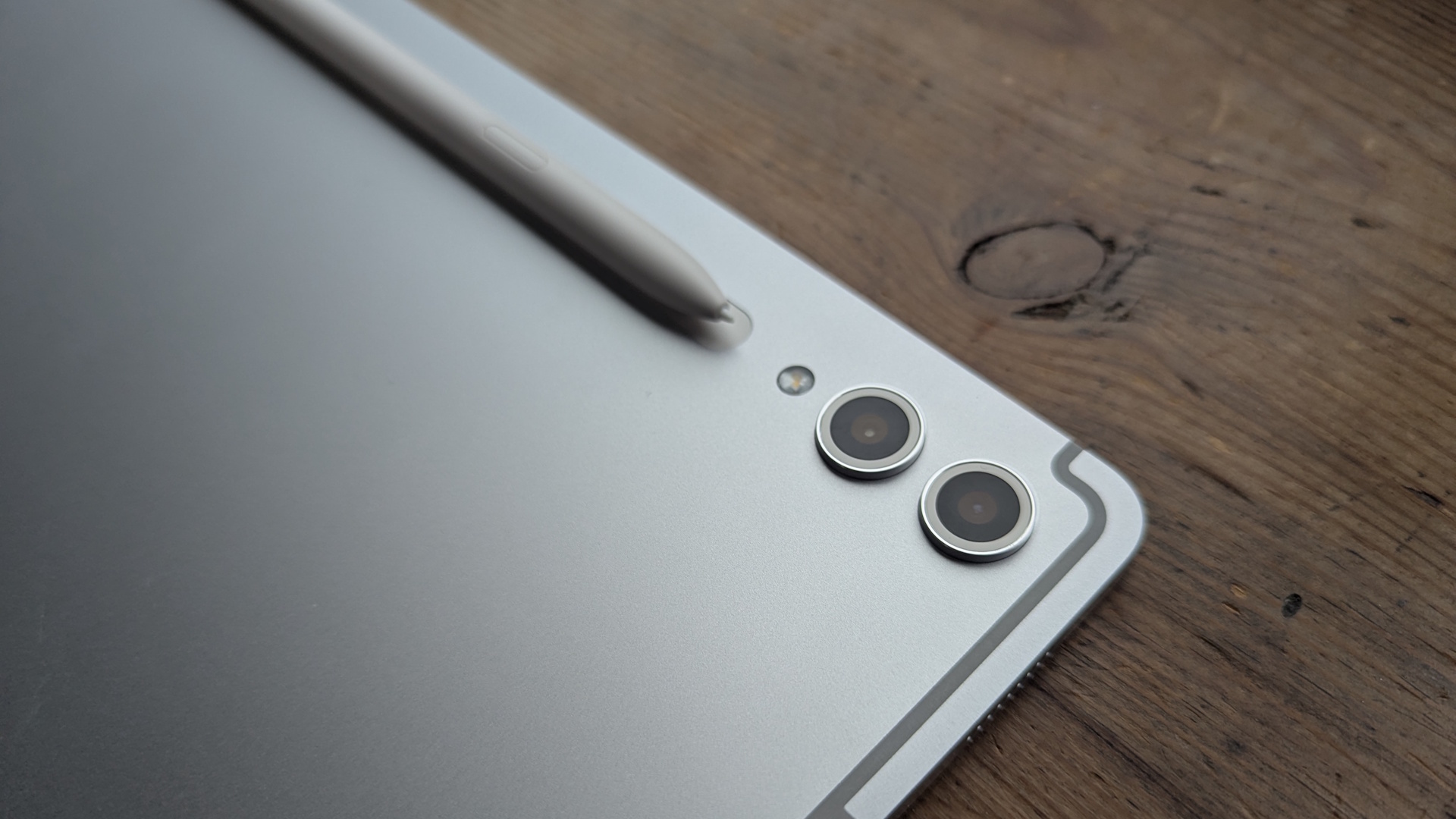Samsung Galaxy Tab S10+ review: Possibly the best Android tablet for business
With good performance, AI features and an exceptional screen, the Tab S10+ is the best Android tablet out there, if not quite the best tablet overall

-
+
+Stunning 12.4in AMOLED screen
-
+
Great performance
-
+
Strong software with useful AI features
-
+
Bundled S-Pen and stylus-ready apps
-
-
No Wi-Fi 7, as on the S10 Ultra
-
-
Battery life could be longer

With Apple dominating the tablet market, selling over 1 in 3 of all devices sold, Samsung has established itself as the only serious competition, with the Galaxy Tab S series as the flagship model. You know what you're getting with a Tab S tablet: cutting-edge specs, Samsung's most advanced features, and arguably the best screens in the business, all at price points that position them directly against Apple's high-end iPad Pro. Well, the new Tab S10+ fits that profile perfectly. It's as good as Android tablets get.
This year there is no 'standard' Tab S10, making the S10+ the most affordable option in the two-strong line-up. With prices starting at £999 and a smaller 12.4in screen, it's both physically and financially more manageable than the 14.6in/£1199 Tab S10 Ultra, and arguably a more practical choice for many users. But do you miss out on anything by plumping for the S10+, and how does the smaller slate hold up against Apple's finest?
Samsung Galaxy Tab S10+: Design
With a few exceptions, the Galaxy Tab S10+ is basically the Tab S10 Ultra, only smaller. Its 285.4 x 185.4mm frame and 571g weight make it easier to stuff inside a bag or use one-handed, and the Tab S10+ works better in situations where space may be limited or you're trying to use your tablet on the go. It comes in the same attractive Moonstone Grey and Platinum Silver finishes, with slim bezels around the screen and the module for the front-facing cameras encroaching in at the center of the top or right-hand edge.
There's no headphone socket, just a USB 3.2 Gen 1 port, which doubles up for charging (up to 45W) and data transfer (up to 5Gbits/sec). The only features on the rear worth noting are the slightly inset magnetic strip that holds the bundled S-Pen securely in place, and the 13MP and 8MP cameras which sit to one side.
Oddly, the S10+ is slightly thicker than the larger S10 Ultra, but only by an unnoticeable fraction of a millimeter. Otherwise, it feels every bit as premium and every bit as robust, with a redesigned framework that's supposed to protect the tablet from drop damage, and IP68 water and dust resistance to keep it safe out on the road.

Samsung Galaxy Tab S10+: Display
The display is smaller than the Galaxy Tab S10 Ultra's and it doesn't go as bright. Where we measured the larger screen hitting 603cd/m2 with SDR content and adaptive brightness turned on, the smaller version maxed out at 497.1cdm/m2. In no other respect could you call it inferior. In fact, the 2800 x 1752 resolution image is spectacularly crisp and clear, with a 266ppi pixel density that beats the Tab S10 Ultra and the 11in iPad Air.
What's more, Samsung's AMOLED tech gives you stunning contrast, punchy colors, and beautifully subtle darker tones. It covers 100% of the sRGB color gamut and 92.8% of DCI-P3, and you could use it for editing movies, not just watching them. Having said that, it's a fantastic way to enjoy Dolby Vision and HDR material, where you can also make the most of the clear and surprisingly rich sound.
We think the 12.4in screen size puts the Tab S10+ in something of a sweet spot, giving you a bigger picture and more working space than you'll get on a standard 11in tablet, without the bulk of the larger 13in and 14in models. It's great for split-screen multitasking, but there's not too much in the way of wasted space when you're working in a single app.
The S10+ gets extra credit for having an effective set of cameras. The dual 12MP front-facing cameras are brilliant for video chats and online meetings, with the option of a wide-angle view. The image is bright, detailed, and consistently well-exposed. And while the rear-facing cameras aren't going to replace a decent smartphone's, they can still take good shots in most lighting, especially if you don't make too much use of the digital zoom. For business purposes, you have everything you need.
Samsung Galaxy Tab S10+: Software and accessories
Samsung's S-Pen has long been one of the Tab S range's killer features, not just because you get it in the box, but because Samsung's apps assume you're going to use it. It makes the Tab S10+ a note-taking, document-annotating, idea-sketching machine out of the box, while also working well for navigating complex productivity and design apps.
What's more, Samsung has designed many of its new Galaxy AI features around the S-Pen, transforming handwritten scrawl into editable text or dubious doodles into slightly less awful illustrations or cartoons. You can also rely on Galaxy AI to translate notes, transcribe recordings, and even craft responses in the messaging and chat apps. The results aren't always perfect – one sample transcription was riddled with misheard nouns and embarrassing mistakes – but there are signs here that Samsung is working out what AI can do to make a tablet more useful in and out of work.
The other strength of Samsung's One UI software is its support for multitasking. Just about every Android tablet now offers split-screen views, but Samsung's approach is more flexible and – with familiarity – more efficient. What's more, Samsung's DEX interface, available at the tap of an icon, transforms One UI into a functional desktop UI, perfect for navigating with the optional AI Book Cover Keyboard or you're a third-party Bluetooth keyboard and mouse. With resizable, floating windows and a dock, you get a laptop-like experience that's perfect for more demanding tasks, especially where you need to work across multiple apps.
Samsung Galaxy Tab S10+: Specs and performance

The Tab S10+ doesn't have the exact same spec as the S10 Ultra. It has Wi-Fi 6E for its network connection rather than the Ultra's Wi-Fi 7, and the battery capacity is smaller, with 10,090mAh instead of 11,200mAh. But when it comes to the MediaTek Dimensity 9300+ CPU and 12GB of RAM, it's identical. It's the joint-fastest Android tablet that money can currently buy.
This translates to Geekbench 6 scores of 2154 in the single-threaded tests and 7154 in multi-core. To put that in perspective, the Huawei MatePad Pro 12.2 we looked at recently scored 1298 and 4272 in the same tests, while the old Galaxy Tab S9 Plus scored 2115 and 5695. With a Snapdragon 8 Gen 2 CPU, the old model was itself no slouch. The S10+ also has some serious 3D horsepower, delivering 30fps in the 3Dmark Wildlife Extreme benchmark, and 13.15fps in the most intensive Steel Nomad Lite test. That might not sound that impressive, but the majority of Android tablets can't get much above 5 to 10fps in the latter test.
The only issue Samsung faces here is that the newest iPad Air and iPad Pro tablets are faster, thanks to their desktop class M2 and M4 processors. There's an argument that most tablet apps don't actually need that kind of power, but if you're looking for maximum performance and the best line-up of professional and creative apps, the iPad Pro is still the way to go. Just bear in mind that the cheapest 13in model will still cost you north of £1250, while the £999 model has a smaller 11in display.
Battery life isn't quite as good as on the iPad Pro or Tab S10+ Ultra. The 11in iPad Pro can last for over 16 hours in our video rundown test, while the bigger Tab S10 can do close to 14 hours. With the S10, the battery ran dry four minutes shy of 13 hours; not a bad result, but a little underwhelming from a tablet that's exceptional in almost every other way.
Samsung Galaxy Tab S10+: Is it worth it?
The Galaxy Tab S10+ is either the best or second-best Android tablet you can buy, depending on how much you value the additional size of the Ultra model. Through the S-Pen, AI features and the One UI, Samsung has done its best to make it a powerful business tool that can run the most demanding Android apps. It is expensive, but the screen, features, and overall quality do a solid job of justifying the premium price. And while Apple still has the performance advantage and the richer app and service ecosystem, a lot of business users are going to find all they need through web-based apps and the Google Play Store. That's enough to make the S10+ a viable alternative to a laptop for travel and mobile use – especially with the right accessories. It's still not going to be your primary PC, but it's a brilliant sidekick slate.
Samsung Galaxy Tab S10+: Specifications
| CPU | MediaTek Dimensity 9300+ | Row 0 - Cell 2 |
| Display | 12.2in AMOLED, 2800 x 1752 resolution | Row 1 - Cell 2 |
| Rear cameras | 13MP - f/2, 8MP wide lens - f/2.2 | Row 2 - Cell 2 |
| Front camera | 12MP - f/2.2, 12MP f/2.4 | Row 3 - Cell 2 |
| RAM | 12GB | Row 4 - Cell 2 |
| Storage | 256GB, 512GB | Row 5 - Cell 2 |
| Ports | Type-C (USB 3.2 Gen 1) | Row 6 - Cell 2 |
| Dimensions (HWD) | 285.4 x 185.4 x 5.6mm | Row 7 - Cell 2 |
| Weight | 571 grams | Row 8 - Cell 2 |
| Battery | 10,090mAh | Row 9 - Cell 2 |
| Operating system | One UI 6.1.1 on Android 14 | Row 10 - Cell 2 |
Get the ITPro daily newsletter
Sign up today and you will receive a free copy of our Future Focus 2025 report - the leading guidance on AI, cybersecurity and other IT challenges as per 700+ senior executives
Stuart has been writing about technology for over 25 years, focusing on PC hardware, enterprise technology, education tech, cloud services and video games. Along the way he’s worked extensively with Windows, MacOS, Linux, Android and Chrome OS devices, and tested everything from laptops to laser printers, graphics cards to gaming headsets.
He’s then written about all this stuff – and more – for outlets, including PC Pro, IT Pro, Expert Reviews and The Sunday Times. He’s also written and edited books on Windows, video games and Scratch programming for younger coders. When he’s not fiddling with tech or playing games, you’ll find him working in the garden, walking, reading or watching films.
You can follow Stuart on Twitter at @SATAndrews.
-
 ‘Phishing kits are a force multiplier': Cheap cyber crime kits can be bought on the dark web for less than $25 – and experts warn it’s lowering the barrier of entry for amateur hackers
‘Phishing kits are a force multiplier': Cheap cyber crime kits can be bought on the dark web for less than $25 – and experts warn it’s lowering the barrier of entry for amateur hackersNews Research from NordVPN shows phishing kits are now widely available on the dark web and via messaging apps like Telegram, and are often selling for less than $25.
By Emma Woollacott Published
-
 Redis unveils new tools for developers working on AI applications
Redis unveils new tools for developers working on AI applicationsNews Redis has announced new tools aimed at making it easier for AI developers to build applications and optimize large language model (LLM) outputs.
By Ross Kelly Published
-
 Google layoffs continue with "hundreds" cut from Chrome, Android, and Pixel teams
Google layoffs continue with "hundreds" cut from Chrome, Android, and Pixel teamsNews The tech giant's efficiency drive enters a third year with devices teams the latest target
By Bobby Hellard Published